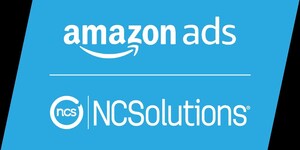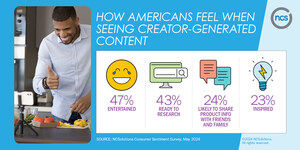- New analysis helps marketers to distinguish and demonstrate the sales lift for recency (recent) vs. iterative (repeat) advertising frequency
- NCSolutions offers free licensing of its patent-pending methodology to industry
NEW YORK, May 10, 2022 /PRNewswire/ -- When it comes to marketing campaigns, recent advertising exposure (or recency frequency) is more effective at increasing incremental sales for consumer packaged goods (CPG) brands than iterative (or repeat) frequency, according to new research analysis from NCSolutions (NCS) about how advertising works.
The findings come from the company's pursuit of how advertising works. This new study separates frequency into two types – recency and iterative. Recency Frequency is defined as frequency that delivers reach within shorter time frames and Iterative Frequency is defined as frequency that delivers the same message repeatedly to a consumer within short periods of time.
NCS's research and development team's latest study set out to better measure and reflect the value of frequency. It wanted to determine whether advertising exposure that reminds its viewers once a week to purchase performs the same as a message consumers see when they are exposed to the same ad several times in a day or week as they consume media on various platforms. The research was unveiled publicly at the recent ARF 2022 Audience X Science conference featuring Leslie Wood, chief research officer, NCS; Ashley Chauvin, global associate director, human intelligence, Mars; and Amy Crooks, senior manager, research and development, NCS.
NCS has applied for a patent on its methodology. Due to the importance to the advertising industry at large, NCS is offering free licensing to industry participants in consideration of attribution whenever the methodology is used or cited.
"Intuitively, marketers know that an exposure that repeatedly delivers the same advertising message to consumers over-and-over again can't be as valuable as reminding them weekly about why they should consider purchasing a product," said Wood, "Our research findings and methodology prove why and provides marketers with a way to further think about how their advertising impacts the customer path to purchase. Ultimately, this approach helps them improve their return on advertising spend or ROAS.
"Being more intentional with how we reach and engage people is important for creating meaningful experiences along the consumer journey and being a sticky brand," said Ashley Chauvin, global associate director, human intelligence, Mars. "This new metric, in particular, could be beneficial in helping us better understand or untangle these experiences and the media we serve to them within these moments to deliver a better experience with and for our brands."
THE HISTORY OF ADVERTISING FREQUENCY
The new research builds on Wood's work with Erwin Ephron in the 1980's and 1990's in bringing and socializing recency theory to the industry. This work led to standardization of one-week reach and frequencies compared to the prior four-week time period standard in effect since the 1950's.
"With the advent of digital in the early 2000's, big numbers drove out small numbers and reach became a more dominant campaign measure. Frequency was no longer measured related to attention, but rather as a lumping of all impressions together. Our new work provides the science for recency frequency all with a nostalgic tip of the hat to our decades-old finding that advertising exposure in close proximity to purchase exerts a powerful influence on sales," said Wood.
Household-level campaign analysis reveals frequency can drive higher sales lift but frequency has diminishing returns and costs more than the lift it delivers. Therefore, frequency of more than once a week has a much lower ROAS and incremental dollars per impression (DPM).
REGISTER FOR LICENSE:
Registration for a free use license is accessible on the company website. For more information about NCS's findings on recency vs. iterative advertising frequency, contact [email protected]. Additionally, you can visit the How Advertising Works website for more research.
ABOUT THE ANALYSIS:
The meta-analysis spanned 68 consumer packaged goods brand campaigns across various categories. It looked at the levels of recency frequency and the relationships between percent recency and also average frequency, campaign length, media spend and CPM.
ABOUT NCS
NCSolutions (NCS) makes advertising work better. Our unrivaled data resources powered by leading providers combine with scientific rigor and leading-edge technology to empower the CPG ecosystem to create and deliver more effective advertising. With NCS's proven approach, brands are achieving continuous optimization everywhere ads appear, through purchase-based audience targeting and sales measurement solutions that have impacted over $25 billion in media spend for our customers. NCS has offices in NYC, Chicago, Tampa, and Cincinnati. Visit us at ncsolutions.com to learn more.
SOURCE NCSolutions

WANT YOUR COMPANY'S NEWS FEATURED ON PRNEWSWIRE.COM?
Newsrooms &
Influencers
Digital Media
Outlets
Journalists
Opted In





Share this article